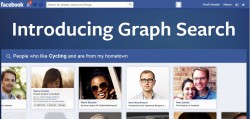 You’ve probably heard the hype about Facebook’s new search utility, which it calls Graph Search. Unveiled just a couples weeks ago, it’s already being described as everything from a LinkedIn killer to a privacy killer, and a recruiter’s new best friend. For every one of those you can find an article — or 100 — that says the opposite.
You’ve probably heard the hype about Facebook’s new search utility, which it calls Graph Search. Unveiled just a couples weeks ago, it’s already being described as everything from a LinkedIn killer to a privacy killer, and a recruiter’s new best friend. For every one of those you can find an article — or 100 — that says the opposite.
Except when it comes to recruiting. While calling it a best friend may be premature, it won’t be long before Graph Search becomes as valuable to recruiters as Google and LinkedIn.
As Stephane Le Viet, CEO of Work4 Labs, wrote in a post on Forbes, “Graph Search is about discovering people — their work history, their education, their interests and their motivations — and using that discovery to recruit better.”
Described simply, Graph Search indexes and quickly accesses all the information each Facebook user has made available. This includes their profiles, photos, comments, likes, friends, and whatever else is out there. Theoretically, what Graph Search does was always possible. In practice, sifting through the thousands of pieces of data was such a huge, time-consuming task, it was all but impossible.
Now, Graph Search can quickly compile lists of almost anything you can think of. Blogger Tom Scott put together an entertaining collection of searches he did on Facebook using Graph Search. Searches like his “Mothers of Jews who like bacon” and the somewhat frightening “Married people who like prostitutes” point up the potential of the tool.
It’s not much of a stretch to see how recruiters will make use of Graph Search, once it’s generally available. (Facebook is rolling out Graph Search slowly, to minimize the potential for the controversy some of its other developments have encountered. To get a jump start, get on the waiting list here.)
My colleague, Lance Haun, did a quick comparison of Facebook and LinkedIn searching for recruiters and software developers who work at Microsoft. In both instances, LinkedIn’s volume was significantly greater. However, Facebook’s search lets you unearth more details. Take one more step and you can find friends of those developers who work for the company looking to fill a developer job. If nothing else, that’s at least a referral opportunity.
Now go one more step and include elements of cultural fit. As a recruiter or sourcer, you’ll need to know how to describe the culture of the company for which you’re recruiting and then translate that into searchable terms. In many cases, that won’t be as daunting as it sounds. A company with an outdoors ethos, say an REI or L.L. Bean, would include relevant descriptors that would turn up candidates who “Like” outdoor activities and show their passion by their activities and the photos they’ve posted or been tagged in.
Clearly, recruiting was in the minds of the developers of Graph Search. During a preview a month before its unveiling, Facebook CEO Marc Zuckerberg told a Wired magazine writer, “One of my favorite queries is recruiting.”
Lars Rasmussen, one of the two leads in developing Graph Search, said during that same preview, “Suppose I want a job at Pinterest — which I don’t, for the record — and I want someone to introduce me there, I can search for my friends who are friends with Pinterest employees.”
Even when Graph Search is widely available, it will have limitations. Its usefulness as a recruiting tool is limited by the number of users who have complete profiles. That percentage is nowhere near LinkedIn’s; business profiles are its raison d’être. Improving the percentage of completed profiles will be crucial to the commercial success of Graph Search, one reason why Facebook has been testing a profile completion bar. Nudging users to fill in the blanks of their profiles will allow the company to better target ads, as well make sourcing candidates more complete.
The search my colleague did of Microsoft recruiters turned up fewer than 100 on Facebook compared to six times that number on LinkedIn. With about a billion Facebook users, it’s not very likely that 506 Microsoft recruiters aren’t among them. Much more likely is that they haven’t filled in those business parts of their profile. Graph Search now gives them a reason to.
Recruiters have mostly had mixed results from social sites. With the exception of LinkedIn — a job board with a business network — and a few tech-oriented sites like Stack Overflow, social media has served more as a place for employers to develop a brand and built contacts, than a means of direct sourcing. Graph Search has the potential of changing that.